Hahn Th. (ed.) International tables for crystallography. Vol. A. Space-group symmetry
Подождите немного. Документ загружается.


circular system (two dimensions) and in the cylindrical and
spherical systems (three dimensions).
The Hermann–Mauguin and Schoenflies symbols for the general
point groups follow the rules of the crystallographic point groups
(cf. Section 2.2.4 and Chapter 12.1). This extends also to the infinite
groups where symbols like 1m or C
1v
are immediately obvious.
In two dimensions (Table 10.1.4.1), the eight general classes are
collected into three systems. Two of these, the 4N-gonal and the
4N 2-gonal systems, contain only point groups of finite order
with one n-fold rotation point each. These systems are general-
izations of the square and hexagonal crystal systems. The circular
system consists of two infinite point groups, with one 1-fold
rotation point each.
In three dimensions (Table 10.1.4.2), the 28 general classes are
collected into seven systems. Three of these, the 4N-gonal, the
2N 1-gonal and the 4N 2-gonal systems,* contain only
point groups of finite order with one principal n-fold symmetry axis
each. These systems are generalizations of the tetragonal, trigonal,
and hexagonal crystal systems (cf. Table 10.1.1.2). The five cubic
groups are well known as crystallographic groups. The two
icosahedral groups of orders 60 and 120, characterized by special
combinations of twofold, threefold and fivefold symmetry axes, are
discussed in more detail below. The groups of the cylindrical and
the spherical systems are all of order infinity; they describe the
symmetries of cylinders, cones, rotation ellipsoids, spheres etc.
It is possible to define the three-dimensional point groups on the
basis of either rotoinversion axes
n or rotoreflection axes
~
n. The
equivalence between these two descriptions is apparent from the
following examples:
n 4N :
4
~
4 8
~
8 ... n
~
n
n 2N 1 :
1
~
2 3
~
6 3 1 ... n
f
2n n 1
n 4N 2 :
2
~
1 m 6
~
3 3=m ... n
f
1
2
n
1
2
n=m:
In the present tables, the standard convention of using rotoinv ersion
axes is followed.
Tables 10.1.4.1 and 10.1.4.2 contain for each class its general
Hermann–Mauguin and Schoenflies symbols, the group order and
the names of the general face form and its dual, the general point
form.† Special and limiting forms are not given, nor are ‘Miller
indices’ (hkl) and point coordinates x, y, z. They can be derived easily
from Tables 10.1.2.1 and 10.1.2.2 for the crystallographic groups.‡
10.1.4.2. The two icosahedral groups
The two point groups 235 and m
3
5 of the icosahedral system
(orders 60 and 120) are of particular interest among the
noncrystallographic groups because of the occurrence of fivefold
axes and their increasing importance as symmetries of molecules
(viruses), of quasicrystals, and as approximate local site symmetries
in crystals (alloys, B
12
icosahedron). Furthermore, they contain as
special forms the two noncrystallographic platonic solids,the
regular icosahedron (20 faces, 12 vertices) and its dual, the regular
pentagon-dodecahedron (12 faces, 20 vertices).
The icosahedral groups (cf. diagrams in Table 10.1.4.3) are
characterized by six fivefold axes that include angles of 63:43
.
Each fivefold axis is surrounded by five threefold and five twofold
axes, with angular distances of 37:38
between a fivefold and a
threefold axis and of 31:72
between a fivefold and a twofold axis.
The angles between neighbouring threefold axes are 41:81
,
between neighbouring twofold axes 36
. The smallest angle
between a threefold and a twofold axis is 20:90
.
Each of the six fivefold axes is perpendicular to five twofold
axes; there are thus six maximal conjugate pentagonal subgroups of
types 52 (for 235) and
5m (for m
3
5) with index [6]. Each of the ten
threefold axes is perpendicular to three twofold axes, leading to ten
maximal conjugate trigonal subgroups of types 32 (for 235) and
3m
(for m
3
5) with index [10]. There occur, furthermore, five maximal
conjugate cubic subgroups of types 23 (for 235) and m
3 (for m
3
5)
with index [5].
The two icosahedral groups are listed in Table 10.1.4.3, in a form
similar to the cubic point groups in Table 10.1.2.2. Each group is
illustrated by stereographic projections of the symmetry elements
and the general face poles (general point s); the complete sets of
symmetry elements are listed below the stereograms. Both groups
are referred to a cubic coordinate system, with the coordinate axes
along three twofold rotation axes and with four threefold axes along
the body diagonals. This relation is well brought out by symbolizing
these groups as 235 and m
3
5 instead of the customary symbols 532
and
5
3m.
The table contains also the multiplicities, the Wyckoff letters and
the names of the general and special face forms and their duals, the
point forms, as well as the oriented face- and site-symmetry
symbols. In the icosahedral ‘holohedry’ m
3
5, the special ‘Wyckoff
position’ 60d occurs in three realizations, i.e. with three types of
polyhedra. In 235, however, these three types of polyhedra are
different realizations of the limiting general forms, which depend
on the location of the poles with respect to the axes 2, 3 and 5. For
this reason, the three entries are connected by braces; cf. Section
10.1.2.4, Notes on crystal and point forms, item (viii).
Not included are the sets of equivalent Miller indices and point
coordinates. Instead, only the ‘initial’ triplets (hkl) and x, y, z for
each type of form are listed. The complete sets of indices and
coordinates can be obtained in two steps§ as follows:
(i) For the fac e forms the cubic point groups 23 and m
3 (Table
10.1.2.2), and for the point forms the cubic space groups P23 (195)
and Pm
3 (200) have to be considered. For each ‘initial’ triplet (hkl),
the set of Miller indices of the (general or special) crystal form with
the same face symmetry in 23 (for group 235) or m
3 (for m
3
5) is
taken. For each ‘initial’ triplet x, y, z, the coordinate triplets of the
(general or special) position with the same site symmetry in P23 or
Pm
3 are taken; this procedure is similar to that described in Section
10.1.2.3 for the crystallographic point forms.
(ii) To obtain the complete set of icosahedral Miller indices and
point coordinates, the ‘cubic’ (hkl) triplets (as rows) and x, y, z
triplets (as columns) have to be multiplied with the identity matrix
and with
(a) the matrices Y, Y
2
, Y
3
and Y
4
for the Miller indic es;
*
Here, the 2N 1-gonal and the 4N 2-gonal systems are distinguished in
order to bring out the analogy with the trigonal and the hexagonal crystal systems.
They could equally well be combined into one, in correspondence with the
hexagonal ‘crystal family’ (cf. Chapter 2.1).
{
The noncrystallographic face and point forms are extensions of the corresponding
crystallographic forms: cf. Section 10.1.2.4, Notes on crystal and point forms. The
name streptohedron applies to the general face forms of point groups
n with n 4N
and n 2N 1; it is thus a generalization of the tetragonal disphenoid or tetragonal
tetrahedron
4 and the rhombohedron 3.
{
The term ‘Miller indices’ is used here also for the noncrystallographic point
groups. Note that these indices do not have to be integers or rational numbers, as for
the crystallographic point groups. Irrational indices, however, can always be closely
approximated by integers, quite often even by small integers.
}
A one-step procedure applies to the icosahedral ‘Wyckoff position’ 12a, the face
poles and points of which are located on the fivefold axes. Here, step (ii) is
redundant and can be omitted. The forms f01g and 0, y, y are contained in the
cubic point groups 23 and m
3 and in the cubic space groups P23 and Pm3 as limiting
cases of Wyckoff positionsf0klg and 0, y, z with specialized (irrational) values of
the indices and coordinates. In geometric terms, the regular pentagon-dodecahedron
is a noncrystallographic ‘limiting polyhedron’ of the ‘crystallographic’ pentagon-
dodecahedron and the regular icosahedron is a ‘limiting polyhedron’ of the
‘irregular’ icosahedron (cf. Section 10.1.2.2, Crystal and point forms).
797
10.1. CRYSTALLOGRAPHIC AND NONCRYSTALLOGRAPHIC POINT GROUPS
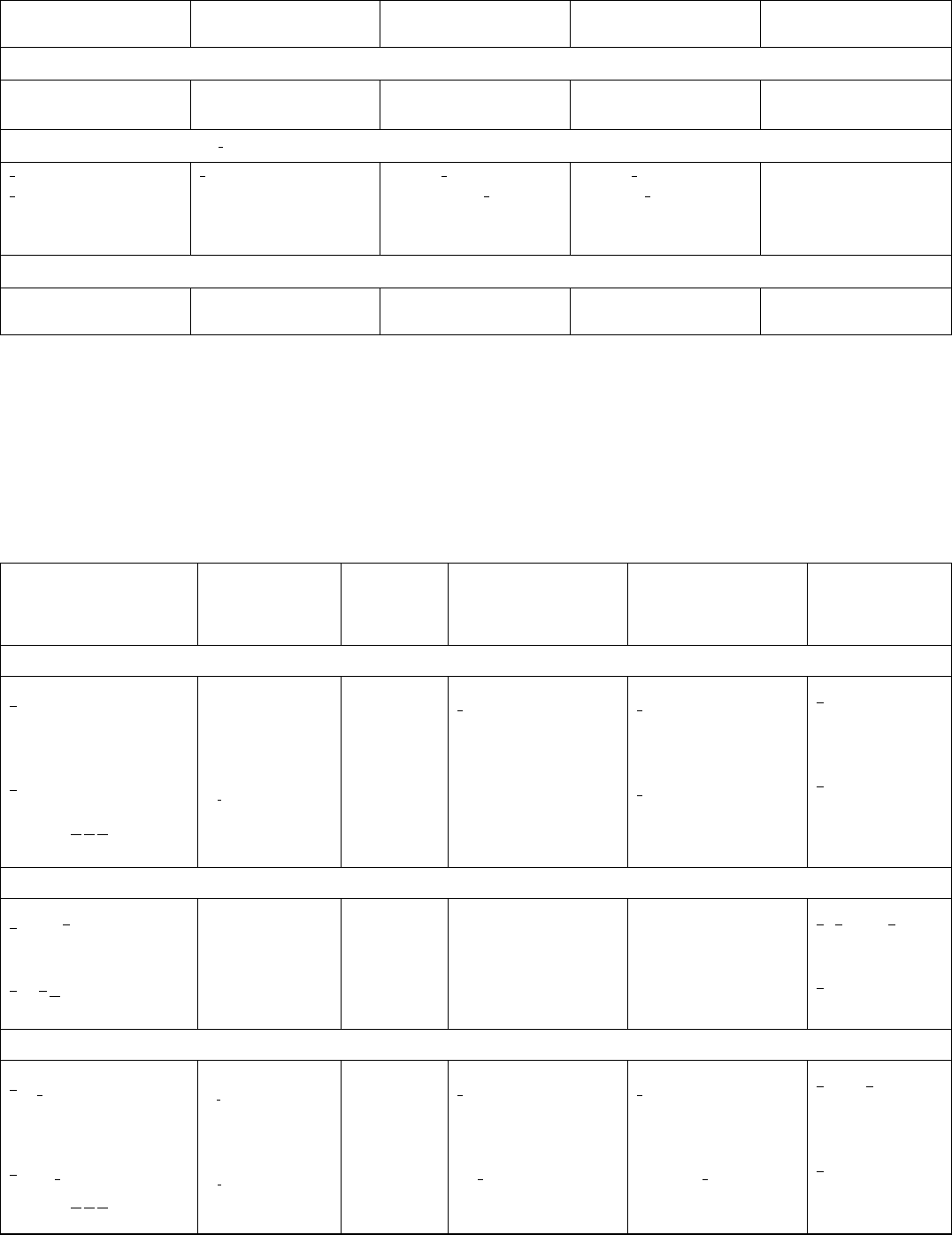
Table 10.1.4.1. Classes of general point groups in two dimensions N integer 0
General Hermann–Mauguin
symbol Order of group General edge form General point form Crystallographic groups
4N-gonal system (n-fold rotation point with n 4N)
nnRegular n-gon Regular n-gon 4
nmm 2n Semiregular di-n-gon Truncated n-gon 4mm
4N 2-gonal system (n-fold or
1
2
n-fold rotation point with n 4N 2)
1
2
n
1
2
n Regular
1
2
n-gon Regular
1
2
n-gon 1, 3
1
2
nm n Semiregular di-
1
2
n-gon Truncated
1
2
n-gon m,3m
nnRegular n-gon Regular n-gon 2, 6
nmm 2n Semiregular di-n-gon Truncated n-gon 2mm,6mm
Circular system *
11Rotating circle Rotating circle –
1m 1 Stationary circle Stationary circle –
* A rotating circle has no mirror lines; there exist two enantiomorphic circles with opposite senses of rotation. A stationary circle has infinitely many mirror lines through its
centre.
Table 10.1.4.2. Classes of general point groups in three dimensions N integer 0
Short general Hermann–
Mauguin symbol, followed
by full symbol where
different Schoenflies symbol
Order of
group General face form General point form
Crystallographic
groups
4N-gonal system (single n-fold symmetry axis with n 4N)
nC
n
nn-gonal pyramid Regular n-gon 4
nS
n
n
1
2
n-gonal streptohedron
1
2
n-gonal antiprism 4
n=mC
nh
2nn-gonal dipyramid n-gonal prism 4=m
n22 D
n
2nn-gonal trapezohedron Twisted n-gonal antiprism 422
nmm C
nv
2n Di-n-gonal pyramid Truncated n-gon 4mm
n2mD
1
2
nd
2nn-gonal scalenohedron
1
2
n-gonal antiprism sliced
off by pinacoid
42m
n=mmm,
n
m
2
m
2
m
D
nh
4n Di-n-gonal dipyramid Edge-truncated n-gonal
prism
4=mmm
2N 1-gonal system (single n-fold symmetry axis with n 2N 1)
nC
n
nn-gonal pyramid Regular n-gon 1, 3
n n 1 C
ni
2nn-gonal strept ohedron n-gonal antiprism 1, 3 3 1
n2 D
n
2nn-gonal trapezohedron Twisted n-gonal antiprism 32
nm C
nv
2n Di-n-gonal pyramid Truncated n-gon 3m
nm, n
2
m
D
nd
4n Di-n-gonal scalenohedron n-gonal antiprism sliced
off by pinacoid
3m
4N 2-gonal system (single n-fold symmetry axis with n 4N 2)
nC
n
nn-gonal pyramid Regular n-gon 2, 6
n
1
2
n=mC
1
2
nh
n
1
2
n-gonal dipyramid
1
2
n-gonal prism 2 m, 6 3=m
n=mC
nh
2nn-gonal dipyramid n-gonal prism 2=m,6=m
n22 D
n
2nn-gonal trapezohedron Twisted n-gonal antiprism 222, 622
nmm C
nv
2n Di-n-gonal pyramid Truncated n-gon mm2, 6mm
n2m
1
2
n=m2mD
1
2
nh
2n Di-
1
2
n-gonal dipyramid Truncated
1
2
n-gonal prism 62m
n=mmm,
n
m
2
m
2
m
D
nh
4n Di-n-gonal dipyramid
Edge-truncated n-gonal
prism
mmm,6=mmm
798
10. POINT GROUPS AND CRYSTAL CLASSES
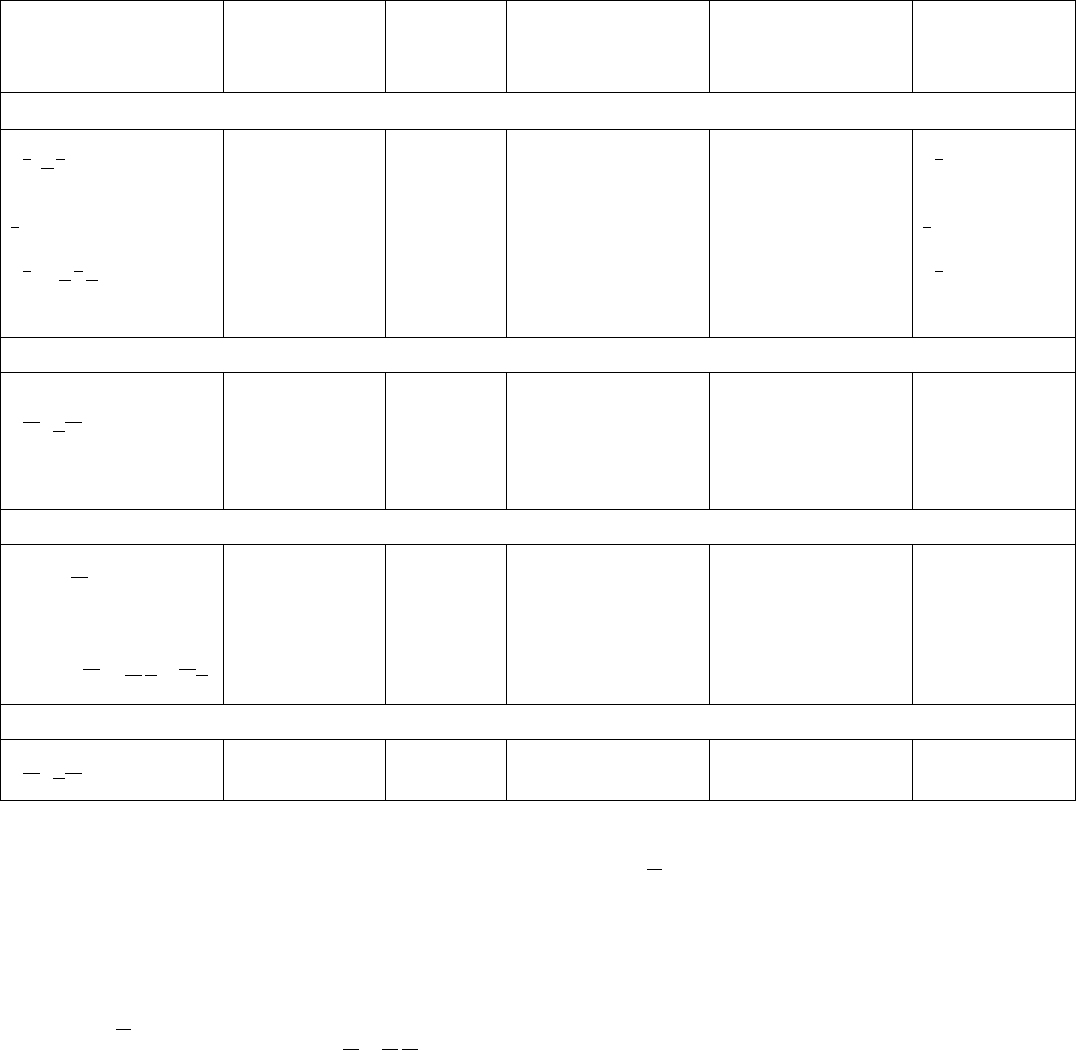
Table 10.1.4.2. Classes of general point groups in three dimensions N integer 0 (cont.)
Short general Hermann–
Mauguin symbol, followed
by full symbol where
different Schoenflies symbol
Order of
group General face form General point form
Crystallographic
groups
Cubic system (for details see Table 10.1.2.2)
23 T 12 Pentagon-tritetrahedron Snub tetrahedron 23
m
3,
2
m
3 T
h
24 Didodecahedron Cube & octahedron &
pentagon-dodecahedron
m3
432 O 24 Pentagon-trioctahedron Snub cube 432
43mT
d
24 Hexatetrahedron Cube truncated by two
tetrahedra
43m
m
3m,
4
m
3
2
m
O
h
48 Hexaoctahedron Cube truncated by
octahedron and by
rhomb-dodecahedron
m3m
Icosahedral system* (for details see Table 10.1.4.3)
235 I 60 Pentagon-
hexecontahedron
Snub pentagon-
dodecahedron
–
m
35,
2
m
35 I
h
120 Hecatonicosahedron Pentagon-dodecahedron
truncated by
icosahedron and by
rhomb-triacontahedron
–
Cylindrical system†
1 C
1
1 Rotating cone Rotating circle –
1=m
1 C
1h
S
1
C
1i
1 Rotating double cone Rotating finite cylinder –
12 D
1
1 ‘Anti-rotating’ double
cone
‘Anti-rotating’ finite
cylinder
–
1mC
1v
1 Stationary cone Stationary circle –
1=mm
1m,
1
m
2
m
1
2
m
D
1h
D
1d
1 Stationary double cone Stationary finite cylinder –
Spherical system‡
21 K 1 Rotating sphere Rotating sphere –
m
1,
2
m
1 K
h
1 Stationary sphere Stationary sphere –
* The Hermann–Mauguin symbols of the two icosahedral point groups are often written as 532 and
5
3m (see text).
† Rotating and ‘anti-rotating’ forms in the cylindrical system have no ‘vertical’ mirror planes, whereas stationary forms have infinitely many vertical mirror planes. In
classes 1and 12, enantiomorphism occurs, i.e. forms with opposite senses of rotation. Class 1=m
1 exhibits no enantiomorphism due to the centre of symmetry, even
though the double cone is rotating in one direction. This can be understood as follows: One single rotating cone can be regarded as a right-handed or left-handed screw,
depending on the sense of rotation with respect to the axial direction from the base to the tip of the cone. Thus, the rotating double cone consists of two cones with opposite
handedness and opposite orientations related by the (single) horizontal mirror plane. In contrast, the ‘anti-rotating’ double cone in class 12 consists of two cones of equal
handedness and opposite orientations, which are related by the (infinitely many) twofold axes. The term ‘anti-rotating’ means that upper and lower halves of the forms rotate
in opposite directions.
‡ The spheres in class 21 of the spherical system must rotate around an axis with at least two different orientations, in order to suppress all mirror planes. This class exhibits
enantiomorphism, i.e. it contains spheres with either right-handed or left-handed senses of rotation around the axes (cf. Section 10.2.4, Optical properties). The stationary
spheres in class m
1 contain infinitely many mirror planes through the centres of the spheres.
Group 21 is sometimes symbolized by 11; group m
1 by 1 1 or 11m. The symbols used here indicate the minimal symmetry necessary to generate the groups; they
show, furthermore, the relation to the cubic groups. The Schoenflies symbol K is derived from the German name Kugelgruppe.
799
10.1. CRYSTALLOGRAPHIC AND NONCRYSTALLOGRAPHIC POINT GROUPS
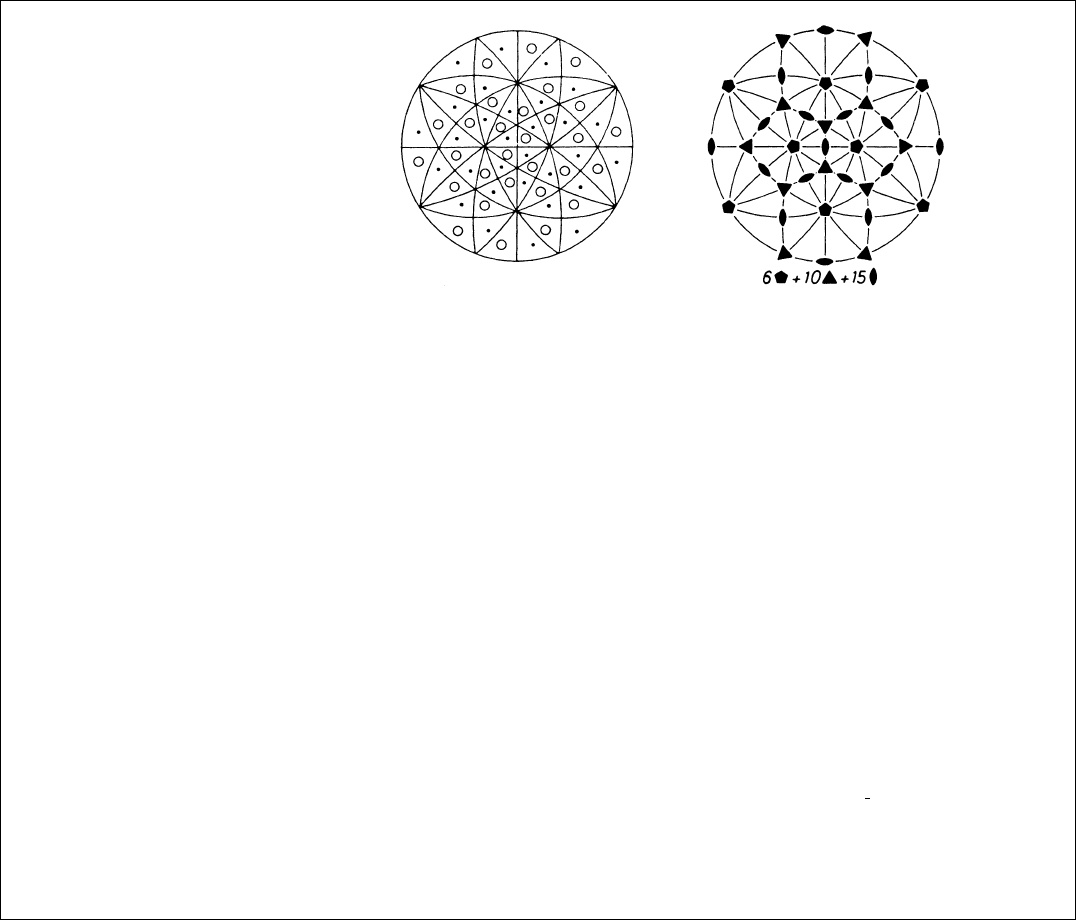
Table 10.1.4.3. The two icosahedral point groups
General, special and limiting face forms and point forms, oriented face- and site-symmetry symbols, and ‘initial’ values of (hkl) and x, y, z (see text).
235 I
60 d 1 Pentagon-hexecontahedron (hkl)
Snub pentagon-dodecahedron (= pentagon-dodecahedron +
icosahedron + pentagon-hexecontahedron)
x, y, z
Trisicosahedron
Pentagon-dodecahedron truncated by icosahedron
poles between axes 2 and 3
Deltoid-hexecontahedron
Rhomb-triacontahedron &
pentagon-dodecahedron & icosahedron
poles between axes 3 and 5
Pentakisdodecahedron
Icosahedron truncated by
pentagon-dodecahedron
poles between axes 5 and 2)
8
>
>
>
>
>
>
>
>
>
>
>
>
>
>
>
>
>
>
>
>
<
>
>
>
>
>
>
>
>
>
>
>
>
>
>
>
>
>
>
>
>
:
0kl with jlj < 0:382jkj
0, y,
z with
jzj < 0:382jyj
0kl with 0:382jkj < jlj < 1:618jkj
0, y, z with 0:382jyj < jzj < 1:618jyj
0kl with jlj > 1:618jkj
0, y, z with jzj > 1:618jyj
30 c 2..
Rhomb-triacontahedron
Icosadodecahedron pentagon-
dodecahedron & icosahedron
100
x,0,0
20 b
.3.
Regular icosahedron
Regular pentagon-dodecahedron
111
x, x, x
12 a ..5
Regular pentagon-dodecahedron
Regular icosahedron
01
0, y, y
with
1
2
5
p
11:618
Symmetry of special projections
Along 001 Along 111 Along 10
2mm 3m 5m
800
10. POINT GROUPS AND CRYSTAL CLASSES
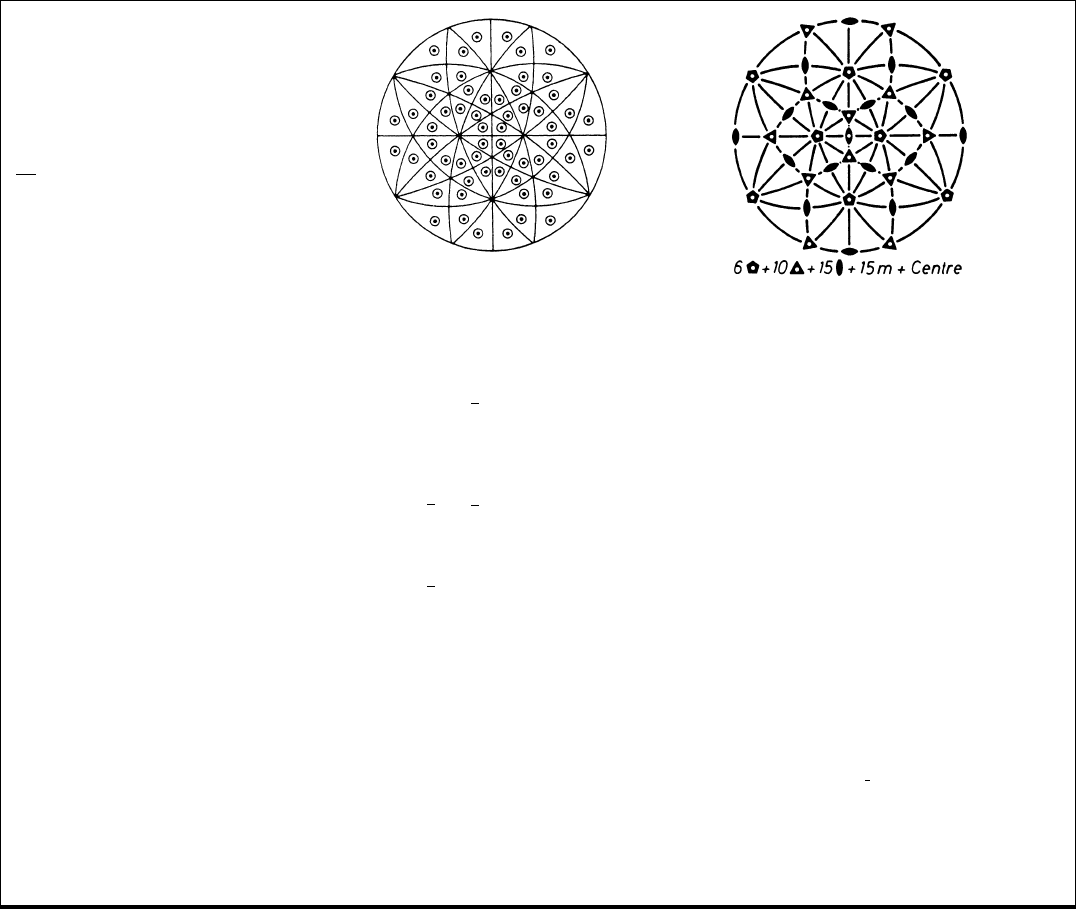
m
3
5
2
m
3
5
I
h
120 e l Hecatonicosahedron or hexaicosahedron (hkl)
Pentagon-dodecahedron truncated by icosahedron and by
rhomb-triacontahedron
x, y, z
60 dm..
Trisicosahedron
Pentagon-dodecahedron truncated by icosahedron
(poles between axes 2 and
3
Deltoid-hexecontahedron
Rhomb-triacontahedron & pentagon-dodecahedron &
icosahedron
(poles between axes
3 and 5
Pentakisdodecahedron
Icosahedron truncated by pentagon-dodecahedron
(poles between axes
5 and 2
8
>
>
>
>
>
>
>
>
>
>
>
>
>
>
>
>
>
>
<
>
>
>
>
>
>
>
>
>
>
>
>
>
>
>
>
>
>
:
0kl with jlj < 0:382jkj
0, y , z with jzj < 0:382jyj
0kl with 0:382jkj < jlj < 1:618jkj
0, y, z with 0:382jyj
< j
zj < 1:618jyj
0kl with jlj > 1:618jkj
0, y, z with jzj > 1:618jyj
30 c 2mm.. Rhomb-triacontahedron (100)
Icosadodecahedron (= pentagon-dodecahedron &
icosahedron)
x,0,0
20 b 3m (m3.) Regular icosahedron (111)
Regular pentagon-dodecahedron x, x, x
12 a 5m (m.5)
Regular pentagon-dodecahedron
Regular icosahedron
01
0, y, y
with
1
2
5
p
11:618
Symmetry of special projections
Along 001 Along 111 Along 10
2mm 6mm 10mm
Table 10.1.4.3. The two icosahedral point groups (cont.)
801
10.1. CRYSTALLOGRAPHIC AND NONCRYSTALLOGRAPHIC POINT GROUPS
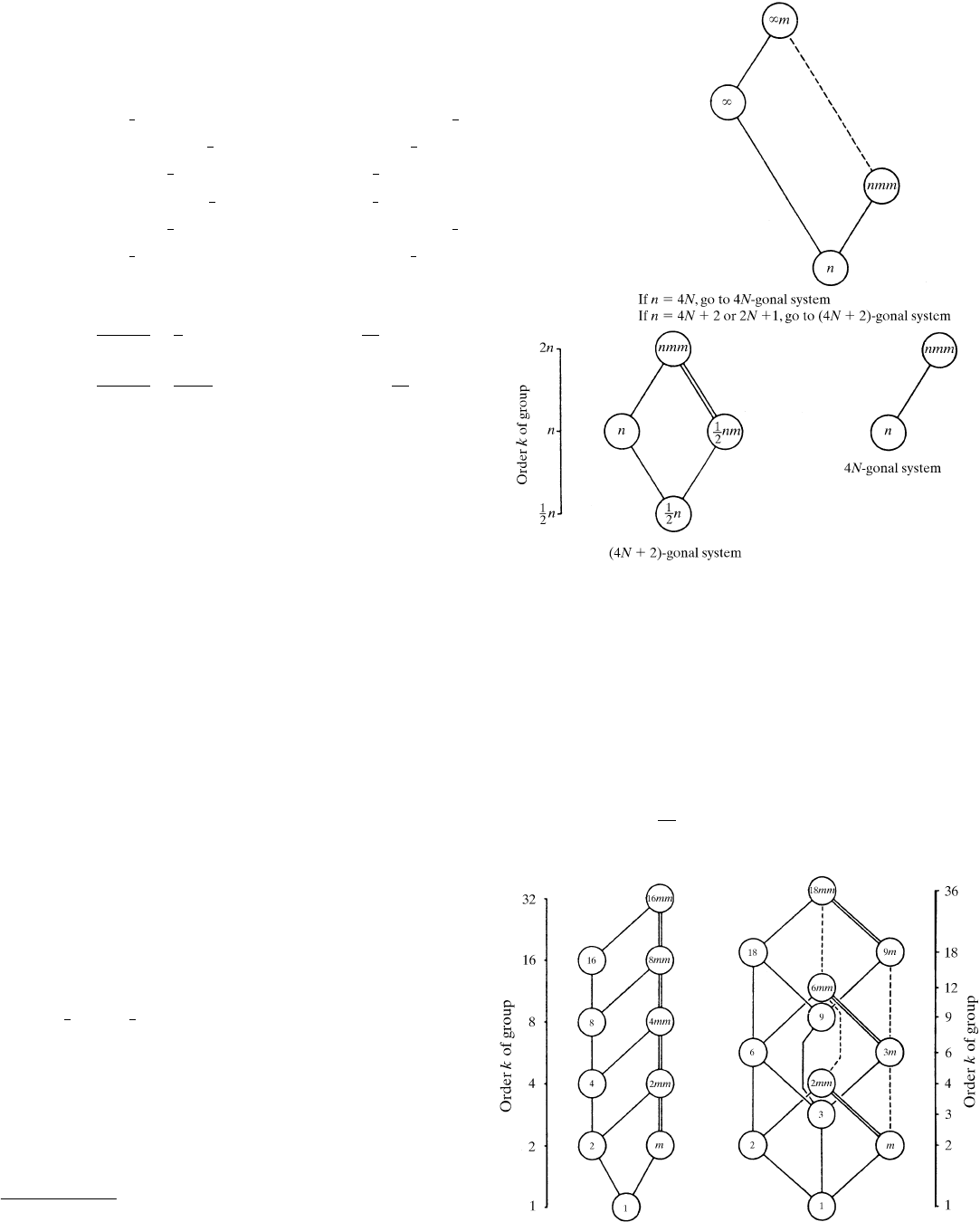
(b) the matrices Y
1
, Y
2
, Y
3
and Y
4
for the point coordinates.
This sequence of matrices ensures the same correspondence
between the Miller indices and the point coordinates as for the
crystallographic point groups in Table 10.1.2.2.
The matrices* are
Y Y
4
1
2
gG
gG
1
2
G
1
2
g
0
B
@
1
C
A
, Y
2
Y
3
gG
1
2
G
1
2
g
1
2
g G
0
B
@
1
C
A
,
Y
3
Y
2
gG
1
2
G
1
2
g
1
2
g G
0
B
@
1
C
A
, Y
4
Y
1
1
2
g G
gG
1
2
G
1
2
g
0
B
@
1
C
A
,
with†
G
5
p
1
4
2
cos 36
0:80902 '
72
89
g
5
p
1
4
1
2
cos 72
0:30902 '
17
55
:
These matrices correspond to counter-clockwise rotations of 72,
144, 216 and 288
around a fivefold axis parallel to 10.
The resulting indices h, k, l and coordinates x, y, z are irrational
but can be approximated closely by rational (or integral) numbers.
This explains the occurrence of almost regular icosahedra or
pentagon-dodecahedra as crystal forms (for instance pyrite) or
atomic groups (for instance B
12
icosahedron).
Further descriptions (including diagrams) of noncrystallographic
groups are contained in papers by Nowacki (1933) and A. Niggli
(1963) and in the textbooks by P. Niggli (1941, pp. 78–80, 96),
Shubnikov & Koptsik (1974) and Vainshtein (1994). For the
geometry of polyhedra, the well known books by H. S. M. Coxeter
(especially Coxeter, 1973) are recommended.
10.1.4.3. Sub- and supergroups of the general point groups
In Figs. 10.1.4.1 to 10.1.4.3, the subgroup and supergroup
relations between the two-dimensional and three-dimensional
general point groups are illustrated. It should be remembered that
the index of a group–subgroup relation between two groups of order
infinity may be finite or infinite. For the two spherical groups, for
instance, the index is [2]; the cylindrical groups, on the other hand,
are subgroups of index [1] of the spherical groups.
Fig. 10.1.4.1 for two dimensions shows that the two circular
groups 1m and 1 have subgroups of types nmm and n,
respectively, each of index [1]. The order of the rotation point
may be n 4N, n 4N 2orn 2N 1. In the first case, the
subgroups belong to the 4 N-gonal system, in the latter two cases,
they belong to the 4N 2-gonal system. [In the diagram of the
4N 2-gonal system, the 2N 1-gonal groups appear with the
symbols
1
2
nm and
1
2
n.] The subgroups of the circular groups are not
maximal because for any given value of N there exists a group with
N
0
2N which is both a subgroup of the circular group and a
supergroup of the initial group.
The subgroup relations, for a specified value of N, within the 4N-
gonal and the 4N 2-gonal system, are shown in the lower part of
the figure. They correspond to those of the crystallographic groups.
A finite number of further maximal subgroups is obtained for lower
values of N, until the crystallographic groups (Fig. 10.1.3.1) are
reached. This is illustrated for the case N 4 in Fig. 10.1.4.2.
Fig. 10.1.4.3 for three dimensions illustrates that the two
spherical groups 2=m
1 and 21 each have one infinite set of
cylindrical maximal conjugate subgroups, as well as one infinite set
Fig. 10.1.4.1. Subgroups and supergroups of the two-dimensional general
point groups. Solid lines indicate maximal normal subgroups, double
solid lines mean that there are two maximal normal subgroups with the
same symbol. Dashed lines refer to sets of maximal conjugate
subgroups. For the finite groups, the orders are given on the left. Note
that the subgroups of the two circular groups are not maximal and the
diagram applies only to a specified value of N (see text). For complete
examples see Fig. 10.1.4.2.
Fig. 10.1.4.2. The subgroups of the two-dimensional general point groups
16mm (4N-gonal system) and 18mm [4N 2-gonal system, including
the 2N 1-gonal groups]. Compare with Fig. 10.1.4.1 which applies
only to one value of N.
*
Note that for orthogonal matrices Y
1
Y
t
t transposed.
{
The number 2G 2g 1 1:618034 (Fibonacci number) is the character-
istic value of the golden section 1 : : 1, i.e. 11. Furthermore,
is the distance between alternating vertices of a regular pentagon of unit edge
length and the distance from centre to vertex of a regular decagon of unit edge
length.
802
10. POINT GROUPS AND CRYSTAL CLASSES
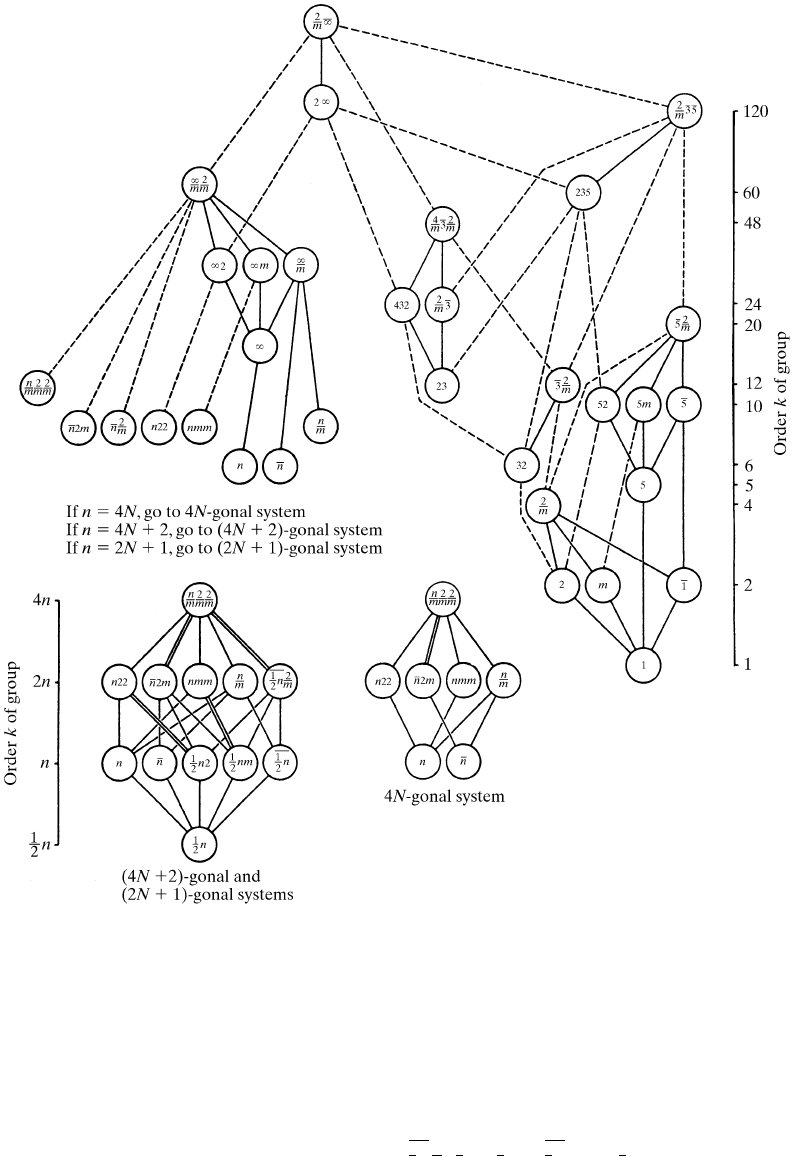
of cubic and one infinite set of icosahedral maximal finite conjugate
subgroups, all of index [1].
Each of the two icosahedral groups 235 and 2=m
3
5 has one set of
five cubic, one set of six pentagonal and one set of ten trigonal
maximal conjugate subgroups of indices [5], [6] and [10],
respectively (cf. Section 10.1.4.2, The two icosahedral groups);
they are listed on the right of Fig. 10.1.4.3. For crystallographic
groups, Fig. 10.1.3.2 applies. The subgroup types of the five
cylindrical point groups are shown on the left of Fig. 10.1.4.3. As
explained above for two dimensions, these subgroups are not
maximal and of index [1]. Depending upon whether the main
symmetry axis has the multiplicity 4N ,4N 2or2N 1, the
subgroups belong to the 4N-gonal, 4N 2-gonal or 2N 1-
gonal system.
The subgroup and supergroup relations within these three
systems are displayed in the lower left part of Fig 10.1.4.3. They
are analogous to the crystallographic groups. To facilitate the use of
the diagrams, the 4N 2-gonal and the 2N 1-gonal systems
are combined, with the consequence that the five classes of
the 2N 1-gonal system now appear with the symbols
1
2
n
2
m
,
1
2
n2,
1
2
nm,
1
2
n and
1
2
n. Again, the diagrams apply to a
specified value of N. A finite number of further maximal subgroups
is obtained for lower values of N, until the crystallographic groups
(Fig. 10.1.3.2) are reached (cf. the two-dimensional examples in
Fig. 10.1.4.2).
Acknowledgements
The authors are indebted to A. Niggli (Zu
¨
rich) for valuable
suggestions on Section 10.1.4, in particular for providing a sketch
of Fig. 10.1.4.3. We thank H. Wondratschek (Karlsruhe) for
stimulating and constructive discussions. We are grateful to R. A.
Becker (Aachen) for the careful preparation of the diagrams.
Fig. 10.1.4.3. Subgroups and supergroups of the three-dimensional general point groups. Solid lines indicate maximal normal subgroups, double sol id
lines mean that there are two maximal normal subgroups with the same symbol. Dashed lines refer to sets of maximal conjugate subgroups. For the
finite groups, the orders are given on the left and on the right. Note that the subgroups of the five cylindrical groups are not maximal and that the
diagram applies only to a specified value of N (see text). Only those crystallographic point groups are included that are maximal subgroups of
noncrystallographic point groups. Full Hermann–Mauguin symbols are used.
803
10.1. CRYSTALLOGRAPHIC AND NONCRYSTALLOGRAPHIC POINT GROUPS

10.2. Point-group symmetry and physical properties of crystals
BY H. KLAPPER AND TH. HAHN
10.2.1. General restrictions on physical properties
imposed by symmetry
The point group of a crystal is the symmetry that is common to all of
its macroscopic properties. In other words, the point group of a
crystal is a (not necessarily proper) subgroup of the symmetry group
of any of its physical properties. It follows that the symmetry group
of any property of a crystal must include the symmetry operations of
the crystal point group. This is the so-called ‘Neumann’s principle’,
which can be used to derive information about the symmetry of a
crystal from its physical properties.
Certain interesting physical properties occur only in noncen-
trosymmetric crystals; cf. Table 10.2.1.1. These are mainly
properties represented by polar tensors of odd rank (e.g.
pyroelectricity, piezoelectricity) or axial tensors of second rank
(e.g. optical activity); see textbooks of tensor physics, e.g. Nye
(1957). These properties are, as a rule, the most important ones, not
only for physical applications but also for structure determination,
because they allow a proof of the absence of a symmetry centre. For
the description of noncentrosymmetric crystals and their specific
properties, certain notions are of importance and these are explained
below. Further detailed treatments of tensor properties are presented
in International Tables for Crystallography Vol. D (2003).
10.2.1.1. Enantiomorphism, enantiomerism, chirality,
dissymmetry
These terms refer to the same symmetry restriction, the absence
of improper rotations (rotoinversions, rotoreflections) in a crystal or
in a molecule. This implies in particular the absence of a centre of
symmetry,
1, and of a mirror plane, m 2, but also of a 4 axis. As a
consequence, such chiral crystals or molecules can occur in two
different forms, which are related as a right and a left hand; hence,
they are called right-handed and left-handed forms. These two
forms of a molecule or a crystal are mirror-related and not
superimposable (not congruent). Thus, the only symmetry opera-
tions that are allowed for chiral objects are proper rotations. Such
objects are also called dissymmetric, in contr ast to asymmetric
objects, which have no symmetry.
The terms enantiomerism and chirality are mainly used in
chemistry and applied to molecules, whereas the term enantio-
morphism is preferred in crystallography if reference is made to
crystals.
Enantiomorphic crystals, as well as solutions or melts containing
chiral mole cules of one handedness, exhibit optical activity (cf.
Section 10.2.4.2). Crystals and molecules of the other handedness
show optical activity with the opposite sense of rotation. For this
reason, two molecules of opposite chirality are also called optical
isomers.
Chiral molecules form enantiomorphic crystals of the corre-
sponding handedness. The crystals belong, therefore, to one of the
11 crystal classes allowing enantiomorphism (Table 10.2.1.1).
Racemic mixtures (containing equal amounts of molecules of each
chirality), however, may crys tallize in non-enantiomorphic or even
centrosymmetric crystal classes. Racemization (i.e. the switching of
molecules from one chirality to the other) of an optically active melt
or solution can occur in some cases during crystallization, leading to
non-enantiomorphic crystals.
Enantiomorphic crystals can also be built up from achir al
molecules or atom groups. In these cases, the achiral molecules
or atom groups form chiral configurations in the structure. The best
known examples are quartz and NaClO
3
. For details, reference
should be made to Rogers (1975).
10.2.1.2. Polar directions, polar axes, polar point groups
A direction is called polar if its two directional senses are
geometrically or physically different. A polar symmetry direction of
a crystal is called a polar axis. Only proper rotation or screw axes
can be polar. The polar and nonpolar directions in the 21
noncentrosymmetric point groups are listed in Table 10.2.1.2.
The terms polar point group or polar crystal class are used in two
different meanings. In crystal physics, a crystal class is considered
as polar if it allows the existence of a permanent dipole moment, i.e.
if it is capable of pyroelectricity (cf. Section 10.2.5). In crystal-
lography, however, the term polar crystal class is frequently used
synonymously with noncentrosymmetric crystal class. The synon-
ymous use of polar and acentric, however, can be misleading, as is
shown by the following example. Consider an optically active
liquid. Its symmetry can be represented as a right-handed or a left-
handed sphere ( cf. Sections 10.1.4 and 10.2.4). The optical activity
is isotropic, i.e. magnitude and rotation sense are the same in any
direction and its counterdirection. Thus, no polar direction exists,
although the liquid is noncentrosymmetric with respect to optical
activity.
According to Neumann’s principle, information about the point
group of a crystal may be obtained by the observation of physical
effects. Here, the term ‘physical properties’ includes crystal
morphology and etch figures. The use of any of the techniques
described below does not necessarily result in the complete
determination of symmetry but, when used in conjunction with
other methods, much information may be obtained. It is important
to realize that the evidence from these methods is often negative, i.e.
that symmetry conclusions drawn from such evidence must be
considered as only provisional.
In the following sections, the physical properties suitable for the
determination of symmetry are outlined briefly. For more details,
reference should be made to the monographs by Bhagavantam
(1966), Nye (1957) and Wooster (1973).
10.2.2. Morphology
If a crystal shows well developed faces, information on its
symmetry may be derived from the external form of the crystal.
By means of the optical goniometer, faces related by symmetry can
be determined even for crystals far below 1 mm in diameter. By this
procedure, however, only the eigensymmetry (cf. Section 10.1.2.2)
of the crystal morphology (which may consist of a single form or a
combination of forms) can be established. The determination of the
point group is unique in all cases where the observed eigensymmetry
group is compatible with only one generating group.
Column 6 in Table 10.1.2.3 lists all point groups for which a
given crystal form (characterized by its name and eigensymmetry)
can occur. In 19 cases, the point group can be uniquely determined
because only one entry appears in column 6. These crystal forms are
always characteristic general forms, for which eigensymmetry and
generating point-group symmetry are identical. They belong to the
19 point groups with more than one symmetry direction.
If a crystal exhibits a combination of forms which by themselves
do not permit unambiguous determination of the point group, those
generating point groups are possible that are common to all crystal
forms of the combination. The mutual orientation of the forms, if
variable, has to be taken into account, too.
Example
Two tetragonal pyramids, each of eigensymmetry 4mm, rotated
with respect to each other by an angle 6 45
, determine the point
804
International Tables for Crystallography (2006). Vol. A, Chapter 10.2, pp. 804–808.
Copyright © 2006 International Union of Crystallography

group 4 uniquely because the eigensymmetry of the combination
is only 4.
In practice, however, unequal or incomplete development of the
faces of a form often simulates a symmetry that is lower than the
actual crystal symmetry. In such cases, or when the morphological
analysis is ambiguous, the crystallization of a small amount of the
compound on a seed crystal, ground to a sphere, is useful. By this
procedure, faces of additional forms (and often of the characteristic
general form) appear as small facets on the sphere and their
interfacial angles can be measured.
In favourable cases, even the space group can be derived from the
morphology of a crystal: this is based on the so-called Bravais–
Donnay–Harker principle (cf. Section 3.1.3). A textbook descrip-
tion is given by Phillips (1971).
Furthermore, measurements of the interfacial angles by means of
the optical goniometer permit the determination of the relative
dimensions of a ‘morphological unit cell’ with good accuracy.
Thus, for instance, the interaxial angles , , and the axial ratio
a:b:c of a triclinic crystal may be derived. The ratio a:b:c, however,
may contain an uncertainty by an integral factor with respect to the
actual cell edges of the crystal. This means that any one unit length
may have to be multiplied by an integer in order to obtain
correspondence to the ‘structural’ unit cell.
10.2.3. Etch figures
Additional information on the point group of a crystal can be gained
from the face symmetry, which is usually determined by
observation of etch figures, striations and other face markings.
Etch pits are produced by heating the crystal in vacuum
(evaporation from the surface) or by attacking it with an appropriate
reagent, which should not be optically active. The etch pits
generally appear at the end points of dislocation lines on the face.
They exhibit the symmetry of one of the ten two-dimensional point
groups which, in general,* corresponds to the symmetry of the
crystal face under investigation.
Table 10.2.1.1. Laue classes, noncentrosymmetric crystal classes, and the occurrence (+) of specific physical effects
For pyroelectricity, the direction of the pyroelectric vector is given (with unique axis b for the monoclinic system).
Crystal system Laue class
Noncentrosymmetric
crystal classes Enantiomorphism Optical activity
Pyroelectricity;
piezoelectricity
under hydrostatic
pressure
Piezoelectricity;
second-harmonic
generation
Triclinic
11 +++[uvw]+
Monoclinic
2
m
2 + + + [010] +
m ++[u0w]+
Orthorhombic
2
m
2
m
2
m
222 + + +
mm2 + + [001] +
Tetragonal
4
m
4 + + + [001] +
4 + +
422 + + +
4
m
2
m
2
m
4mm + [001] +
42m + +
Trigonal
3 3 + + + [001] +
3
2
m
32 + + +
3m + [001] +
Hexagonal
6
m
6 + + + [001] +
6 +
622 + + +
6
m
2
m
2
m
6mm + [001] +
62m +
Cubic
2
m
3
23 + + +
4
m
3
2
m
432 + +
43m +
*
It should be noted, however, that asymmetric etch figures may occur that are due,
for example, to an inclination of dislocation lines against the surface.
805
10.2. POINT-GROUP SYMMETRY AND PHYSICAL PROPERTIES OF CRYSTALS

The observation of etch figures is important when the
morphological analysis is ambiguous (cf. Section 10.2.2). For
instance, a tetragonal pyramid, which is compatible with point
groups 4 and 4mm, can be uniquely attributed to point group 4 if its
face symmetry is found to be 1. For face symmetry m, group 4mm
would result. The (oriented) face symmetries of the 47 crystal forms
in the various point groups are listed in column 6 of Table 10.1.2.3
and in column 3 of Table 10.1.2.2.
In noncentrosymmetric crystals, the etch pits on parallel but
opposite faces, even though they have the same symmetry, may be
of different size or shape, thus proving the absence of a symmetry
centre. Note that the orientation of etch pits with respect to the
edges of the face is significant (cf. Buerger, 1956), as well as the
mutual arrangement of etch pits on opposite faces. Thus, for a
pinacoid with face symmetry 1, the possible point groups
1, 2 and m
of the crystal can be distinguished by the mutual orientation of etch
pits on the two faces. Moreover, twinning by merohedry and the
true symmetry of the two (or more) twin partners (‘twin domains’)
may be detected.
The method of etching can be applied not only to growth faces
but also to cleavage faces or arbitrarily cut faces.
10.2.4. Optical properties
Optical studies provide good facilities to determine the symmetry of
transparent crystals. The following optical properties may be used.
10.2.4.1. Refraction
The dependence of the refractive index on the vibration direction
of a plane-polarized light wave travelling through the crystal can be
obtained from the optical indicatrix. This surface is an ellipsoid
which can degenerate into a rotation ellipsoid or even into a sphere.
Thus, the lowest symmetry of the property ‘refraction’ is 2/m 2/m
2/m, the point group of the general ellipsoid. According to the three
different forms of the indicatrix three categories of crystal systems
have to be distinguished (Table 10.2.4.1).
The orientation of the indicatrix is related to the symmetry
directions of the crystal. In tetragonal, trigonal and hexagonal
crystals, the rotation axis of the indicatrix (which is the unique optic
axis) is parallel to the main symmetry axis. For orthorhombic
crystals, the three principal axes of the indicatrix are oriented
parallel to the three symmetry directions. In the monoclinic system,
one of the axes of the indicatrix coincides with the monoclinic
symmetry direction, whereas, in the triclinic case, the indicatrix can,
in principle, have any orientation relative to a chosen reference
system. Thus, in triclinic and, with restrictions, in monoclinic
crystals, the orientation of the indicatrix can change with
wavelength and temperature T (orientation dispersion). In any
system, the size of the indicatrix and, in all but the cubic system, its
shape can also vary with and T.
When studying the symmetry of a crystal by optical means, note
that strain can lower the apparent symmetry owing to the high
sensitivity of optical properties to strain.
10.2.4.2. Optical activity
The symmetry information obtained from optical activity is quite
different from that given by optical refraction. Optical activity is in
principle confined to the 21 noncentrosymmetric classes but it can
occur in only 15 of them (Table 10.2.1.1). In the 11 enantiomorph-
Table 10.2.1.2. Polar axes and nonpolar directions in the 21
noncentrosymmetric crystal classes
All directions normal to an evenfold rotation axis and along rotoinversion axes
are nonpolar. All directions other than those in the column ‘Nonpolar
directions’ are polar. A symbol like [u0w] refers to the set of directions
obtained for all possible values of u and w, in this case to all directions normal
to the b axis, i.e. parallel to the plane (010). Symmetrically equivalent sets of
nonpolar directions are placed between semicolons; the sequence of these sets
follows the sequence of the symmetry directions in Table 2.2.4.1
System Class
Polar (symmetry)
axes Nonpolar directions
Triclinic 1 None None
Monoclinic 2 [010] [u0w]
Unique axis bm None [010]
Monoclinic 2 [001] [uv0]
Unique axis cm None [001]
Orthorhombic 222 None [0vw]; [u0w]; [uv0]
mm2 [001] [uv0]
Tetragonal 4 [001] [uv0]
4 None [001]; [uv0]
422 None [uv0]; [0vw][u0w];
[uuw][u
uw]
4mm [001] [uv0]
42m None [uv0]; [0vw][u0w]
4m2 None [uv0]; [uuw][u
uw]
Trigonal 3 [001] None
(Hexagonal
axes)
321 [100], [010], [
1
10] [u2uw][
2u
uw][u
uw]
312 [1
10], [120], [
2
10] [uuw][
u0w][0
vw]
3m1 [001] [100] [010] [
1
10]
31m [001] [1
10] [120] [
2
10]
Trigonal 3 [111] None
(Rhombohedral
axes)
32 [1
10], [01
1], [
101] [uuw][uvv][uvu]
3m [111] [1
10] [01
1] [
101]
Hexagonal 6 [001] [uv0]
6 None [001]
622 None [u2uw][
2u
uw][u
uw]
[uuw][
u0w][0
vw]
6mm [001] [uv0]
6m2[1
10], [120], [
2
10] [uuw][
u0w][0
vw]
62m [100], [010], [
1
10] [u2uw][
2u
uw][u
uw]
Cubic
23
43m
Four threefold
axes along h111i
[0vw][u0w][uv0]
[0vw][u0w][uv0]
432
None
8
<
:
[0vw][u0w][uv0];
[uuw][uvv][uvu];
[u
uw][uv
v][
uvu]
Table 10.2.4.1. Categories of crystal systems distinguished
according to the different forms of the indicatrix
Crystal system Shape of indicatrix Optical character
Cubic Sphere Isotropic (not doubly refracting)
Tetragonal
Trigonal
Hexagonal
9
=
;
Rotation ellipsoid
Uniaxial
Biaxial
9
>
>
=
>
>
;
Anisotropic
(doubly
refracting)
Orthorhombic
Monoclinic
Triclinic
9
=
;
General ellipsoid
806
10. POINT GROUPS AND CRYSTAL CLASSES
